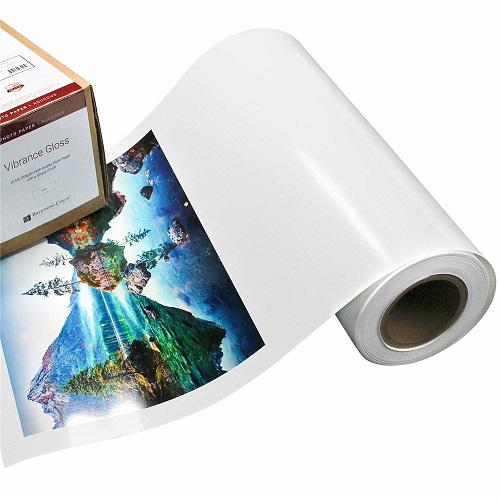The Science and Precision of High Gloss Paper: Engineering Reflectivity, Texture, and Print Performance
In the world of modern print technology, few materials embody precision and visual brilliance as effectively as high gloss paper. Its smooth, mirror-like surface has become a hallmark of premium production—used in photography, luxury packaging, advertising, and fine art reproduction.
Substrate Engineering
The foundation of any high gloss paper lies in its base stock—typically a high-grade wood-free or chemically pulped cellulose sheet. To achieve the rigidity and uniformity necessary for gloss coating, manufacturers employ bleached chemical pulps, refined to achieve a controlled fiber length distribution.
- Filler optimization: Calcium carbonate (CaCO₃) or kaolin clay is incorporated to improve opacity and smoothness.
- Moisture control: Relative humidity during base stock formation is maintained between 45–55%, preventing micro-warping during subsequent coating.
- Calendering: Before coating, the paper is passed through supercalenders operating at pressures exceeding 200 kg/cm², compressing fibers and creating a near-mirror foundation.
Coating Composition
High gloss paper owes its luminous surface to multi-layer coating systems engineered for specific reflectance and ink interaction.
A typical high gloss layer comprises three primary components:
- Pigments: Ultra-fine particles such as precipitated calcium carbonate (PCC) or synthetic silica, with an average particle size below 0.4 μm, form a dense optical layer that scatters and reflects light uniformly.
- Binders: Synthetic latex polymers, most commonly styrene-butadiene (SB) or styrene-acrylate (SA) emulsions, provide film-forming properties and flexibility.
- Additives: Rheology modifiers, optical brightening agents (OBAs), and cross-linkers ensure flow uniformity, brightness enhancement, and coating integrity.
The coating is applied through blade coating or air knife coating, achieving wet film thicknesses between 10–15 μm. Following application, infrared pre-drying and hot-air convection drying bring the moisture content below 5%, preparing the surface for calendering.
Finishing and Calendering: Creating the Gloss Layer
To reach the final gloss finish, the coated sheet undergoes gloss calendering—a thermal-mechanical process using heated steel rolls at temperatures around 120–160°C. Under pressures of 250–350 kg/cm², the coating surface softens and reflows, creating a microscopically flat surface with a surface roughness (Ra) below 0.2 μm.
At this stage, optical properties are optimized for specular reflection rather than diffuse scattering. The result is a surface capable of reflecting 60–85% of incident light, producing the characteristic “wet look” prized in luxury print applications.
Print Interaction: Ink, Absorption, and Adhesion
High gloss papers are designed for precision offset, gravure, or digital inkjet printing.
Each printing method interacts differently with the coated surface:
- Offset printing: The hydrophobic latex binder network provides excellent ink holdout, reducing penetration and increasing color density.
- Inkjet printing: Surface energy is critical. A pre-treatment layer is often applied to regulate ink drop spread, achieving dot gain values below 10%.
- Gravure printing: The ultra-smooth surface supports high-resolution image reproduction with line screens exceeding 200 LPI (lines per inch).
Colorimetric data show that gloss paper achieves ΔE < 1.0 in repeat color calibration, a benchmark of professional-grade consistency.
Optical and Mechanical Performance Testing
Quality control for high gloss paper includes a battery of standardized tests:
| Property | Typical Range | Test Standard |
| Gloss (at 75°) | 70–90 GU | ISO 8254-1 |
| Brightness | 92–98% | ISO 2470 |
| Opacity | >90% | ISO 2471 |
| Smoothness (Bekk) | >10,000 s | ISO 5627 |
| Tensile Strength (MD/CD) | 5.5 / 3.5 kN/m | ISO 1924 |
These parameters ensure consistency across production runs and guarantee compatibility with high-speed press systems.
Sustainability and Evolving Technology
Modern high gloss paper production faces environmental scrutiny. Manufacturers are transitioning toward biopolymer binders, water-based coatings, and closed-loop effluent treatment systems. Innovations such as nanoclay-modified coatings and UV-curable finishes are reducing energy use while maintaining high gloss metrics.
Digital gloss simulation technologies, integrating 3D microtopography scanning and gloss prediction algorithms, allow for non-destructive quality assurance, bridging traditional papermaking and digital modeling.
High gloss paper represents a convergence of materials science, surface engineering, and printing technology. Beyond its aesthetic appeal lies a precise orchestration of fiber alignment, coating chemistry, and thermal finishing. As printing moves toward greater sustainability and digital integration, the evolution of gloss paper continues—reflecting not just light, but the technical ingenuity behind its creation.






























